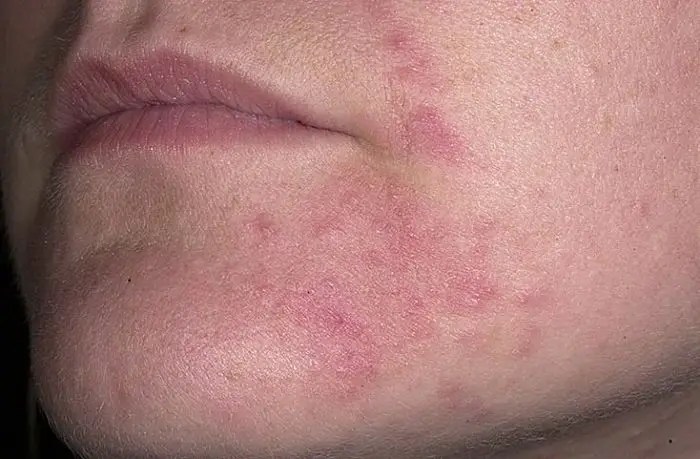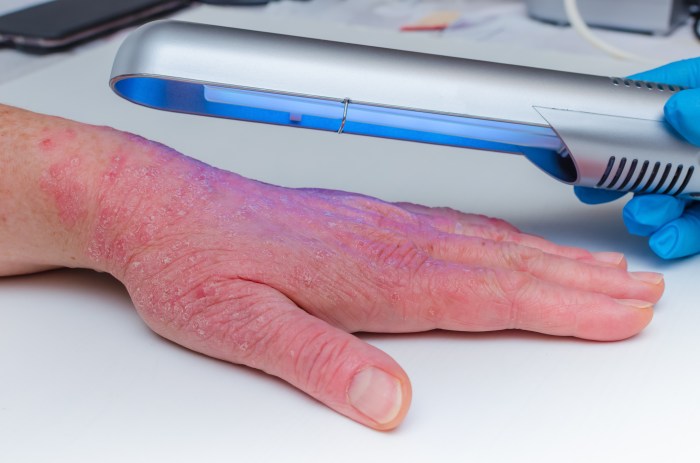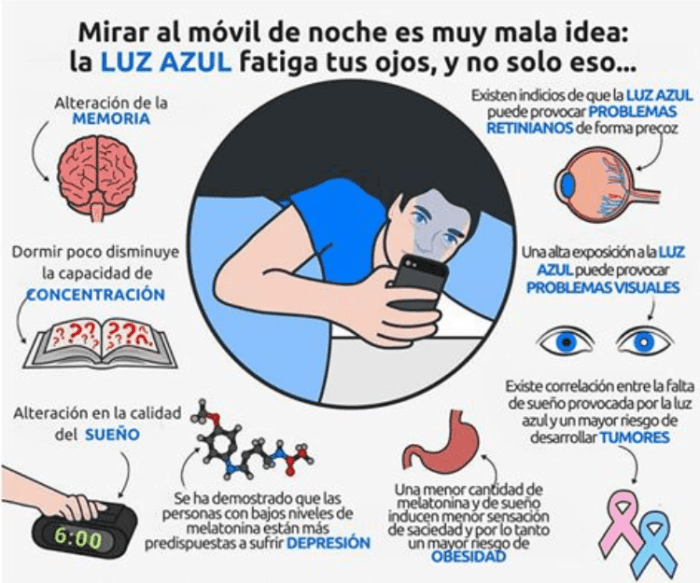Alergia a la luz uv led – UV LED light allergy, a condition triggered by exposure to ultraviolet light emitted by LED devices, has emerged as a growing concern. This guide delves into the intricacies of this allergy, exploring its causes, symptoms, diagnosis, and treatment options, empowering individuals to effectively manage their condition.
Understanding UV LED light allergy is crucial, as it can manifest in various ways, affecting the skin, eyes, and overall well-being. This guide provides a comprehensive overview, arming readers with the knowledge they need to navigate this condition confidently.
Introduction

Ultraviolet (UV) LED light is a type of light that emits electromagnetic radiation in the ultraviolet spectrum. It has various applications, including water purification, medical treatments, and industrial processes.
UV LED light allergy is a rare condition in which individuals develop an allergic reaction to exposure to UV LED light. Symptoms of UV LED light allergy can include skin rashes, itching, and swelling.
Causes of UV LED Light Allergy

UV LED light allergy, also known as LED photodermatitis, is a condition where the skin reacts abnormally to exposure to ultraviolet (UV) light emitted by LED devices. The exact cause of this allergy is not fully understood, but several factors are believed to contribute to its development.
Genetic Factors
Genetic predisposition may play a role in the development of UV LED light allergy. Some individuals may have a genetic susceptibility to developing an allergic reaction to UV light. This susceptibility can be inherited from parents who have a history of UV light allergy or other skin conditions that involve photosensitivity.
Environmental Triggers
Exposure to certain environmental triggers can also contribute to the development of UV LED light allergy. These triggers may include:
- Sunlight:Exposure to natural sunlight can exacerbate symptoms of UV LED light allergy. This is because sunlight also emits UV rays, which can trigger an allergic reaction in susceptible individuals.
- Artificial UV light sources:UV LED light allergy can be triggered by exposure to artificial UV light sources, such as those found in tanning beds, nail lamps, and some types of LED lighting.
- Certain chemicals:Contact with certain chemicals, such as those found in some cosmetics and fragrances, can make the skin more sensitive to UV light and increase the risk of developing an allergy.
Symptoms of UV LED Light Allergy

Exposure to UV LED light can trigger a range of symptoms, from mild skin reactions to more severe systemic effects. The most common symptoms include:
- Skin reactions, such as redness, itching, swelling, and blistering.
- Eye irritation, including redness, watering, and pain.
- Systemic effects, such as headache, fatigue, and nausea.
Skin Reactions
Skin reactions to UV LED light can vary in severity, depending on the individual’s sensitivity and the intensity and duration of exposure. Common skin reactions include:
- Erythema (redness)
- Pruritus (itching)
- Edema (swelling)
- Blistering
- Hyperpigmentation (darkening of the skin)
- Hypopigmentation (lightening of the skin)
Diagnosis of UV LED Light Allergy
Diagnosing UV LED light allergy involves a thorough medical history, physical examination, and specialized tests. A detailed medical history can help identify potential triggers, such as previous exposure to UV LED light sources or related products. During the physical examination, the doctor will assess the skin for signs of an allergic reaction, such as redness, swelling, or blisters.
Patch Testing
Patch testing is a common method for confirming a UV LED light allergy. In this test, small patches containing different concentrations of UV LED light are applied to the skin. The patches are left on for 24-48 hours, and the skin is then examined for any reactions.
A positive reaction indicates an allergy to UV LED light.
Phototesting
Phototesting is another specialized test used to diagnose UV LED light allergy. This test involves exposing the skin to different wavelengths of UV light, including UV LED light, and then observing the skin’s response. A positive reaction, such as redness or inflammation, confirms an allergy to UV LED light.
Treatment of UV LED Light Allergy
Treatment for UV LED light allergy focuses on reducing symptoms and preventing further exposure. Various options are available:
Topical Medications
Topical medications, such as corticosteroids or calamine lotion, can be applied directly to the affected areas to reduce inflammation and itching.
Oral Medications
In severe cases, oral medications like antihistamines or oral corticosteroids may be prescribed to suppress the immune response and alleviate symptoms.
Phototherapy
Phototherapy involves exposing the skin to controlled amounts of UV light in a controlled setting. This can help desensitize the skin and reduce sensitivity to UV LED light.
Lifestyle Modifications, Alergia a la luz uv led
Lifestyle modifications are crucial to reduce exposure to UV LED light:
- Avoid prolonged exposure to UV LED light sources, such as LED screens and UV lamps.
- Use sunscreen and protective clothing when outdoors.
- Wear UV-blocking sunglasses.
- Consider using UV filters on windows and electronic devices.
Prevention of UV LED Light Allergy

To prevent UV LED light allergy, it is essential to take proactive measures to minimize exposure and protect your skin and eyes.
Protective Clothing and Eyewear:
- Wear clothing that covers your skin, such as long sleeves and pants, when exposed to UV LED light sources.
- Invest in UV-blocking sunglasses that meet the ANSI Z80.3 standard to protect your eyes from harmful radiation.
Sunscreen:
While researching o air and soil whitman , I stumbled upon a curious connection to UV LED light allergy. It’s a rare condition where exposure to specific wavelengths of UV light, commonly found in LED lamps, triggers an immune response.
The symptoms range from mild skin irritation to severe blistering. Understanding this condition can help us appreciate the complexities of our bodies and the potential health risks associated with modern technologies.
- Apply a broad-spectrum sunscreen with an SPF of 30 or higher before going outdoors or near UV LED light sources.
- Reapply sunscreen every two hours or more often if swimming or sweating.
Avoid Excessive Exposure:
- Limit your time spent under UV LED light sources, especially during peak hours of sunlight.
- Be mindful of potential sources of UV LED light, such as LED lamps, nail dryers, and tanning beds.
Case Studies and Examples: Alergia A La Luz Uv Led
Case studies and examples can provide valuable insights into the clinical presentation, diagnosis, and management of UV LED light allergy.
Here are some case studies that illustrate the challenges and complexities of this condition:
Case 1
- A 45-year-old woman presented with a several-month history of a pruritic rash on her face and hands that worsened after exposure to sunlight or artificial light sources.
- Physical examination revealed erythema, edema, and papules on the affected areas.
- Patch testing with UV LED light confirmed the diagnosis of UV LED light allergy.
- Treatment with topical corticosteroids and avoidance of UV LED light sources resulted in significant improvement in the patient’s symptoms.
Key findings:UV LED light allergy can cause a pruritic rash that worsens with exposure to light.
Lessons learned:Patch testing is essential for confirming the diagnosis of UV LED light allergy.
Future Research and Advancements

The field of UV LED light allergy is still in its early stages of research, but there are a number of promising advancements that are currently underway. These include the development of new treatment options, preventive measures, and diagnostic tools.
One of the most promising areas of research is the development of new treatment options. Currently, there is no cure for UV LED light allergy, but there are a number of treatments that can help to manage the symptoms. These treatments include topical creams, oral medications, and light therapy.
Another area of research is the development of preventive measures. These measures can help to reduce the risk of developing UV LED light allergy or to prevent the symptoms from worsening. Some of the preventive measures that are currently being investigated include wearing protective clothing, using sunscreen, and avoiding exposure to UV LED light.
Diagnostic Tools
Finally, researchers are also working to develop new diagnostic tools for UV LED light allergy. These tools can help to identify people who are allergic to UV LED light and to track the progress of the disease.
Question Bank
What are the common symptoms of UV LED light allergy?
Symptoms may include skin rashes, redness, itching, burning, and swelling. Some individuals may also experience eye irritation, such as redness, tearing, and discomfort.
How is UV LED light allergy diagnosed?
Diagnosis typically involves a detailed medical history, physical examination, and specialized tests such as patch testing and phototesting.
What are the treatment options for UV LED light allergy?
Treatment may include topical medications to reduce inflammation, oral medications to suppress the immune system, and phototherapy to desensitize the skin to UV light.